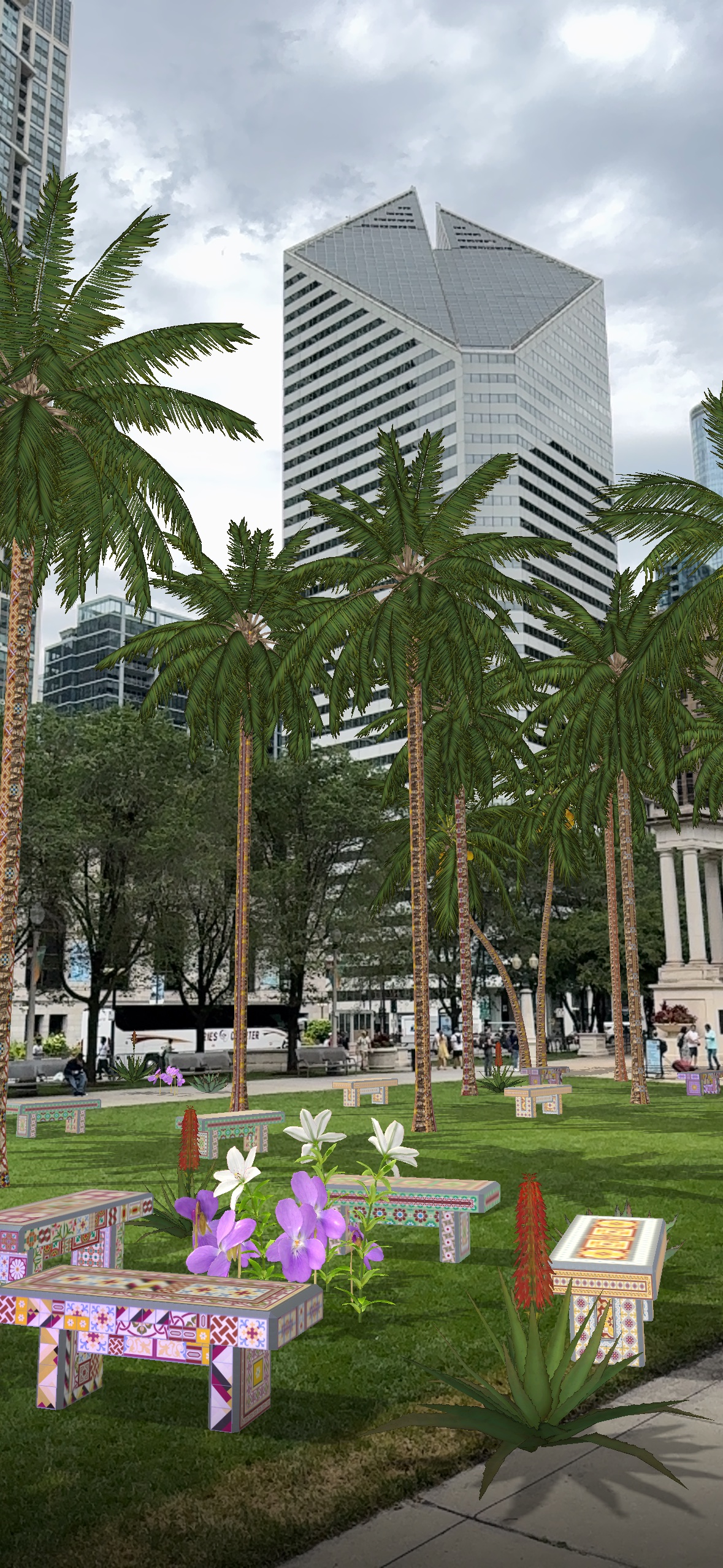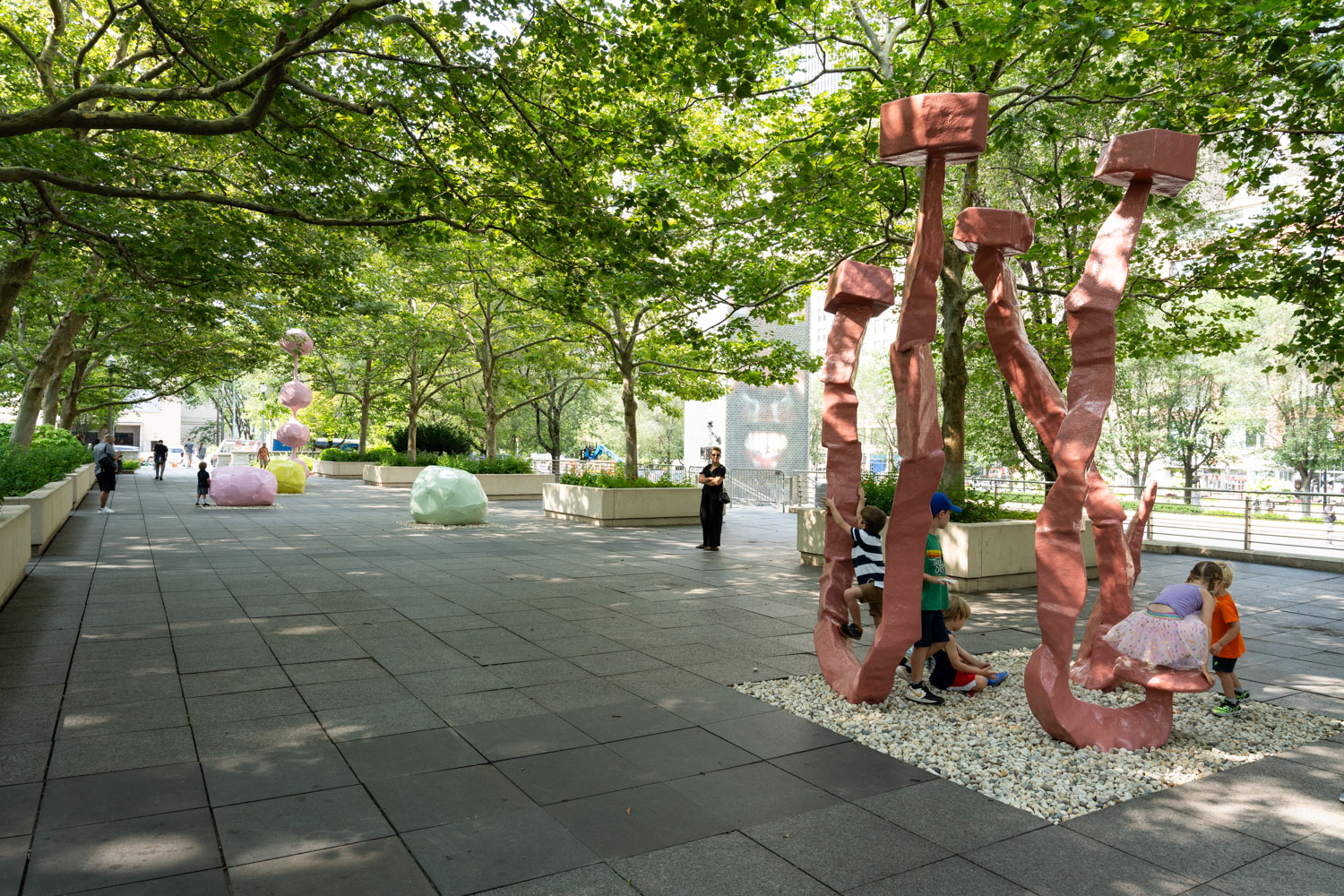To mark its 20th anniversary, Millennium Park has refreshed its public art offerings. The plaza surrounding Anish Kapoor’s iconic Cloud Gate has been renovated, Jaume Plensa’s beloved Crown Fountain got its seasonal cleaning, and works by artists local and international have been temporarily installed throughout.
Some of these, like a gaggle of giant funny forms by the late Austrian sculptor Franz West, are exactly where you would expect to find them, on the ground, bright and bold, in the south Boeing Gallery, the outdoor art space that forms a terrace overlooking Crown Fountain. West, who died in 2012, made notoriously goofy, colorful public sculptures, like a cross between Play-Doh and ancient land art, and these are no exception. “Stonehenge” is dusty rose and 11 feet tall, a circle of wobbly looking verticals with impossibly balanced blocks on top, and with a handy little stool built right into one of its lower ends. “Kugeln (Balls)” appear to be huge shiny pastel rocks, and “Dorit” absurdly suspends four more of those boulders, only bubblegum pink, along a thin, 20-foot-long pole. West’s sculptures are radically gleeful takes on the very stuff of public monuments, plus, being made of lacquered fiberglass and aluminum, they’re friendly to use for young and old alike. Take a seat! Climb aboard! Bang away!
The other new public artworks in Millennium Park are not physically in the park at all, only virtually so, and you’ll need your smartphone and a special app to view them. “Augmented Chicago: Inaugural Realities” is a first for the city, which commissioned a motley group of well-known local artists — Claire Ashley, Faheem Majeed, Yvette Mayorga and Carlos Rolón — to create augmented reality artworks for individual sites throughout the park.
At each location, a sign directs viewers to download a free app called Hoverlay. From there, you scan a QR code, wait for the art to load, then follow onscreen instructions about where to point your phone. And voilà! An original artwork appears superimposed in the landscape, as if it were really there. Ashley’s funky neon meteor hovers over the wildflowers of the Lurie Garden, with a brood of wee meteorites orbiting it chaotically. Majeed’s trio of newsstands rise majestically in the Madison Street allée, displaying almost 200 years of Black broadsheets, with high enough resolution that even the smallest articles are legible. Twenty paces to the west, floating between an endless valley of skyscrapers, is an enormous dancing couple surrounded by loads of frilly Rococo curlicues, courtesy of Mayorga. Dour Wrigley Square, redesigned by Rolón, becomes a surreal place of patterned palm trees, oversized tropical flora, fabulously tiled benches and a cascading waterfall.
Visitors can walk around and get views of the artworks from all sides, from far away and up close. I mean, way up close — you can walk straight through Ashley’s rainbow blob if you want to, it won’t hurt. Some have sound effects, like the song of the coqui frog, a native of Puerto Rico, that fills Rolón’s oasis. All are mobile: Majeed’s newsstands cyclically soar to towering heights then shrink back down again, while magic brooms paste up new front pages and the wind blows others away. And one, Ashley’s, will change with the seasons.
Sure, there are the expected technological frustrations. I couldn’t get Majeed’s artwork to load and had to try again a few hours later. The first time I tried to see Rolón’s, Mayorga’s appeared in its place. But it mostly worked. If you’ve got a smartphone, you can probably figure it out.
The technology itself will be familiar to anyone who has ever played Pokémon GO. Indeed, the development of augmented reality has progressed far enough that it is no longer just the purview of video game designers and tech artists, much like how photography went from being a highly specialized medium to an entirely ubiquitous one. And the possibilities are seemingly endless: an AR tour of the Circus Maximus in Rome visualizes how it looked from the archaic period all the way through the era of Mussolini; users of apps like Kinfolk and MoMAR can visit unauthorized virtual installations of public monuments across New York City and even in the galleries of the Museum of Modern Art.
None of the folks in “Augmented Chicago” have worked in the digital realm before, and what they’ve done in Millennium Park feels very much in keeping with what they normally do, though with the added bonus that gravity, among other limitations of the physical world, has no effect in AR. Nor do finances, for that matter: curator Lucas Cowan estimates that the project cost about one-third less to create, install and maintain than would have conventional commissions by the same artists, plus savings of time, energy, materials and other resources.
Ultimately, though, an AR artwork has to make sense as an AR artwork, not just as something easier to make digitally than physically. Give me inflatable paintings by Ashley any day, anywhere, over the screensaver versions; their sheer ridiculous physicality must be real to be believed. Mayorga’s “The Lovers Dance” would probably be silly no matter the medium. Majeed’s newsstands could go either way: they’d be glorious as a physical monument to the history of Black-owned media, but their virtuality renders them a moving thought experiment, a vision of what it might look like if mainstream American media had always been centered on the Black experience.
As for Rolón’s tropicalized plaza, well, as much as I dislike a bench I can’t sit down on and a flower I can’t smell, they poignantly capture the situation of the person who pines for a place and a culture that are far away. He has titled it “Ni Aquí, Ni Allá (Neither Here, Nor There),” and it’s as wrong as it is right. I can’t wait to experience it in the winter.
Lori Waxman is a freelance critic.
“Franz West: Millennium Park” and “Augmented Chicago: Inaugural Realities” run through November 2025 and are installed around Millennium Park, 201 E. Randolph St., chicago.gov






